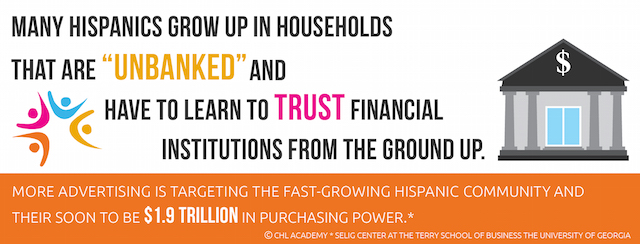
Money 101: It's Elementary
11/29/2013 10:58AM | 9695 viewsOnce kids start asking for things they see in the store or on TV, it’s not long before most parents hammer home their first personal finance lesson: Money doesn’t grow on trees. From there, how can we teach them other basic money concepts?
This is becoming a particular problem for Hispanic parents, as more advertising is targeting the fast-growing Hispanic community and their soon to be $1.5 trillion in purchasing power. According to Mayra Serrano, community interventionist at CCARE, City of Hope, “One of our more recent goals has been to teach kids to recognize these ads and to be more media savvy in general. From there, it’s an easy segue to teaching them about money.”
Children as young as 3 can be introduced to money, and by age 10, they can even manage a simple savings account and budget, says Ann Freel, director of Family Education and Governance Services for Northern Trust.

Consider these eight ideas to teach your younger kids to save money, spend it wisely and watch it grow – just not on trees.
- Use money to teach kids
about math, and vice versa. Introduce your youngest kids to money as they learn
to count. Once they can subtract, kids can make change. When they learn
percentages, they can figure out an appropriate tip for a restaurant server.
“This is also a great opportunity to share a bit of wisdom about financial etiquette
and being gracious to those who provide service,” Freel says.
- Help kids understand the
difference between needs and wants. Be mindful of how you talk about purchasing
decisions and your own wants and needs. As children get older, Freel suggests explaining
the choices you make, including tradeoffs, from grocery staples to vacation
destinations. This helps share your family’s priorities and values regarding
money.
According to Glenn Llopis, CEO/Founder of Center for Hispanic Leadership, “Many Hispanics experienced crisis and change in their mother countries or as new immigrants to this country, so they learned early on to put their needs ahead of their wants. Awakening this characteristic in your children will enable them to anticipate the unexpected and plan for the inevitable rainy days ahead.”
- Don’t stop at just one
piggy bank. As soon as kids start acquiring money from grandparents, the Tooth
Fairy and other sources, they can learn to make allocation decisions instead of
throwing it into one pot. “One way is to give them three separate banks for
their money: one for saving, one for spending and one for charitable giving, if
that’s a family priority,” Freel says. “Tell them what each bank is for, using
specific examples that gently and positively reinforce family expectations.”
For Hispanic households, this is a natural extension of the way children are brought up. “When we are very young, we are taught to think of others as much as ourselves,” Llopis explains. “Then when we are older, we are taught that we are part of a larger community – and that it is important to share the harvest of our good fortune.”
Around ages 8-10, some parents ask their children to contribute part of their savings for a special item they want. Others incentivize saving or giving by matching the amounts their children put aside for these purposes.
- Give kids earning
opportunities. However you feel about allowance, children should have
opportunities to make money so they can learn how it relates to time and effort.
Make a list of age-appropriate tasks – separate from normal household
responsibilities – with corresponding dollar amounts children can earn. Offer a
variety of jobs and amounts. Gathering laundry could earn some quick cash for
the ice cream truck, while a larger job, such as weeding the flower beds, could
help kids earn spending money and pad their savings. “One error families may
make is creating all big earning tasks,” Freel says. “This age group has a
short attention span. Keep the tasks relatively simple so kids find the
experience of earning money a positive and achievable one.”
Adds Llopis, “This is another natural extension of the Hispanic culture. In America, you can be entrepreneur, but in our mother countries, we often must be an entrepreneur, just to survive. Giving kids opportunities to earn their own money is a great way to jumpstart their entrepreneurial spirit.”
- Address income
discrepancies. At a young age, children start to notice the differences between
their home and belongings, and others’ possessions. According to Jose Ortiz, who
was born in the barrios of Mexico and now studies at UCLA after developing an
interest in medical research at City of Hope’s Summer Student Academy, “After
moving to the U.S. as a young child, I began to realize that not every family
was the same – everyone has struggles but not necessarily as hard as we had
it. Many of my new classmates came from
good homes and their parents had well-paying jobs. But no matter what our background or status
level or cultural identity, we did have one thing in common – we were all
pursuing the American Dream. I began to
believe that we too could better ourselves.”
For those without the benefit of this perspective, as they begin to associate effort with money, they might draw the conclusion that the less wealthy don’t work as hard. “Explain to them that some people take jobs that pay less for a lot of different reasons,” Freel says. Explore some of the simpler ones, such as passions and preferences, with younger children. “For Hispanics, following our passionate pursuits is a natural characteristic that enables our children to choose their own path and keep from straying when the road gets tough,” Llopis says. Trickier reasons like educational disadvantages can be addressed at an older age. “During these conversations, parents should also share their thoughts about what is more important than money in their family – for example, liking friends for who they are rather than what they have,” she says.
- Open a savings account in
your child’s name. This can be an excellent way to teach kids from 8-10 what
interest is and how it works. Demonstrate the interest they will earn on their
savings account – for example, 1% monthly interest – using a dollar bill and a
penny. “Additionally, children should understand how important it is to save
their money in a safe place like a bank,” Freel says. Explain that bank-related
paperwork contains sensitive information that needs to be kept secure.
“Many Hispanics grow up in households that are ‘unbanked’ and have to learn to trust banks and financial institutions from the ground up,” Llopis explains. “Opening a savings account for your child is a great opportunity to break the cycle and instill financial literacy in them from a very young age.”
If kids want to occasionally withdraw a portion of their savings to buy something, discuss it but don’t forbid it. For kids under 10, making their account seem like a black hole might discourage them from depositing.
- Introduce the concept of
credit. When you swipe plastic, there’s no visible exchange of money for goods.
Early on, explain to kids that the credit card substitutes for money you
already have in the bank and that there’s only so much of it. Later, explain
credit card payments as borrowed money you have to pay back with interest and
fees if you don’t do so on time.
- Hispanic households are
very family-centric, so involve kids in household finances. Kids as young as 9
or 10 can develop a sense of stewardship by managing, or at least keeping an
eye on, parts of the family budget – particularly parts that are personal and
relatable to them. For example, ask a child to help create a realistic budget
for one of their sports or hobbies that the family can track together. Share
the prior year’s costs, such as weekly lessons, uniforms and travel. Then have
the kids factor in incidentals and optional expenses like concession stand
treats, team photos and equipment upgrades.
Turn Family Time Into Financial Education
- By setting aside time for family members to manage their financial lives together, you can reinforce practical skills and find more opportunities to instill your family’s “money values.” Consider these tips:
- Make it normal, casual and regular. Some families designate one Friday a month as “budget night,” during which family members review their monthly saving, spending and giving over their favorite food.
- Keep it age appropriate and engaging, using websites and worksheets for younger children.
- Use these meetings to plan vacations, discuss major household purchases, and establish financial priorities and expectations as a family.
- In short, help children learn about financial matters from an early age by looking for teachable "money moments" in your family's day-to-day life. Give children plenty of financial practice when they're young, rather than waiting until they're older.
- “Young kids are fascinated by how the adult world works, so parents can leverage this natural interest by starting financial education and financial conversations at a young age,” Freel says. “Children who have early, positive experiences building their own ‘nest egg,’ and then making choices about how to use it, tend to be more responsible with money as they grow older.”











Post your Comment
Please login or sign up to comment
Comments